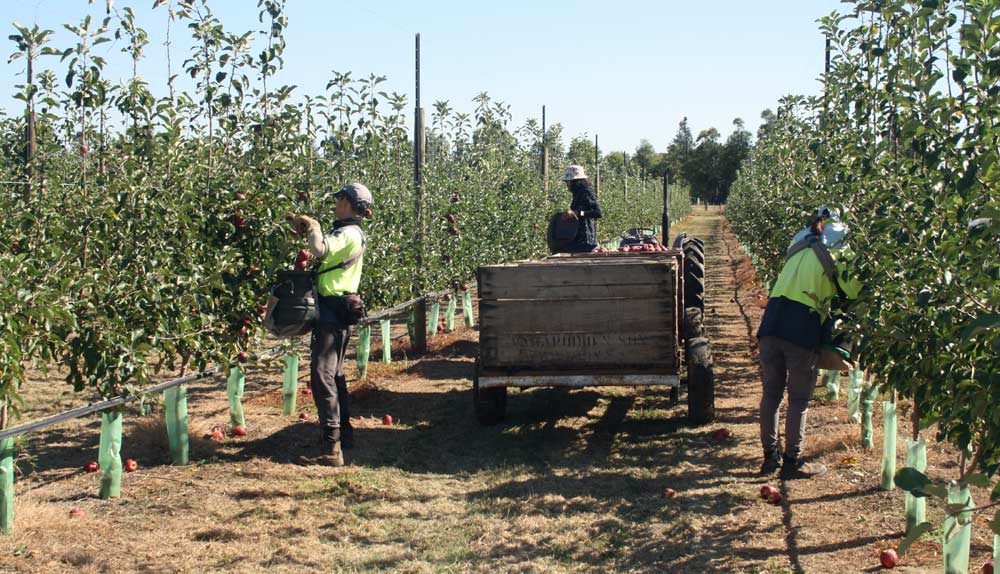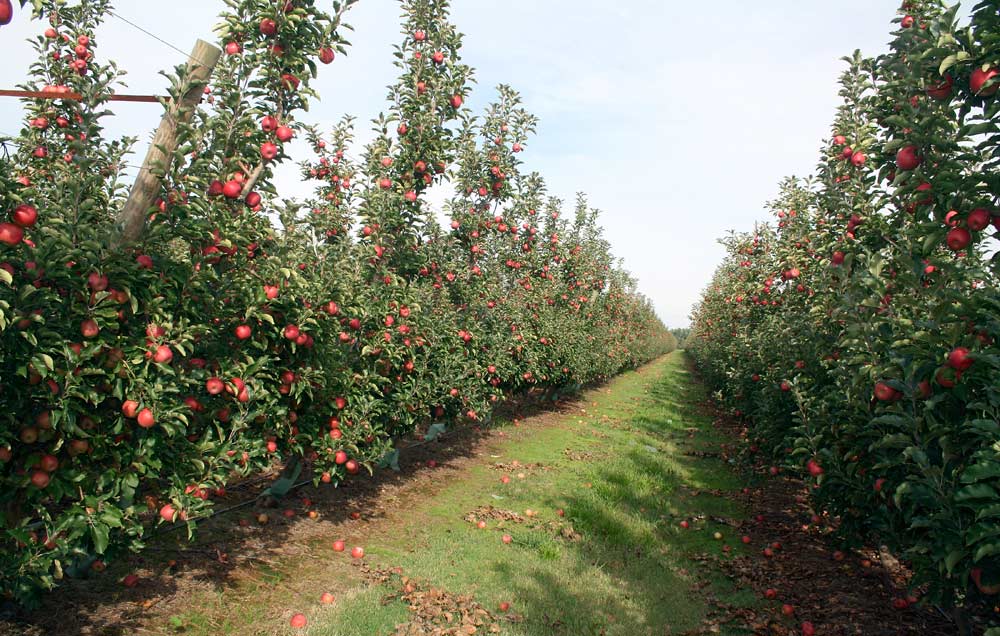
Figure 1. These Modi trees on Malling 9 rootstock, planted at 2,500 trees per hectare (one hectare is about 2.47 acres), are trained on an upright trellis, are growing in a shallow topsoil in southeastern Australia and have experienced three hot summers since planting. Although the trees are well managed, canopy development and initial yield in year three (7 metric tons — a metric ton is about 1.1 U.S. tons — per hectare) lagged well behind yield benchmarks for the appropriate tree density and rootstock. It will probably take at least seven years for canopies to develop completely and for trees to reach full production, compared with up to five years for trees on M.9 in deep topsoils and cool climates. (Courtesy Bas van den Ende)
The Malling 9 rootstock is widely used in high-density plantings of apples in many countries. Trees on this dwarfing rootstock have shown good precocity, high tree efficiency (a measure of fruit yield in relation to the mass of wood), early fruit maturity, excellent fruit size and resistance to collar rot (Phytophthora).
Fruit growers often claim that M.9 also improves the quality of the fruit. However, it is difficult to determine what effects M.9 has on fruit quality, other than yield or size of fruit.
If there is any difference, it is possibly due to more light penetration in the canopy than due to the rootstock. If the rootstock did have an effect, it would depend very much on the variety, the location of the orchards and management of the trees.
M.9 was selected as a dwarfing rootstock at East Malling Research Station in 1912 and, in the years since, strains of M.9 have earned a reputation as outstanding rootstocks for vigorous nonspur varieties.
It is therefore not surprising that fruit industries and nurseries around the world encourage fruit growers to plant apple trees on M.9 at higher tree densities than before. But is this always a good move? Do all climates and soils suit apple trees on M.9?
Fruit growers choose rootstocks not only for tree size and efficiency. A rootstock must be carefully selected to match the orchard system, the vigor of the variety, the growth potential of the climate and the soil. There is no one best dwarfing rootstock for all climates and soils.
M.9 has a small root system, affected to some extent by variety. An awareness of the shortcomings of M.9 could help fruit growers improve orchard performance when rootstocks are matched to prevailing climates and soils in their particular regions.
Root growth

Figure 2. These Pink Lady trees on Malling-Merton 106, trained on Open Tatura, have been growing over four hot summers since planting in the same location and soil type as those in Figure 1. Accumulated yield of two harvests from these 4-year-old trees (64 metric tons per hectare) exceeded the production benchmark for any other rootstock (60 metric tons per hectare), and at a lower tree density (2,222 trees per hectare) than in Figure 1. (Courtesy Bas van den Ende)
In countries with long, hot summers, tree vigor can be low in many apple orchards. In particular, M.9 is well known to be sensitive to high soil temperatures, i.e. above 77 degrees Fahrenheit (25 degrees Celsius), possibly because M.9 does not grow new roots at those temperatures, especially feeding roots.
Roots grow best in the range of 68 to 77 degrees F (20 to 25 degrees C). Above 77 degrees F, root growth slows down, and above 95 degrees F, no new roots grow. This means that with long hot summers, root growth of trees on M.9 is restricted, especially in the upper depths of soil where most of the feeder roots grow. And the distribution of assimilate between roots, frame and fruit is ultimately controlled by the growth of the roots.
Roots not only store carbohydrates and nutrients, roots also synthesize growth substances such as cytokinins and gibberellins. These growth substances produced in the roots are transported to the top of the tree and control shoot growth.
When growth of the root system slows down or stops altogether at high soil temperatures, the production of cytokinins in new roots may also slow down or stop, limiting shoot growth.
Thus, decreased root growth decreases shoot growth. There is no doubt that roots, acting through a hormonal control, play a major role in the maintenance and balance of the growth of the whole tree.
In some countries, such as Chile, there has been a significant trend toward high-density planting on M.9 rootstocks in newer blocks, but semi-dwarfing rootstocks such as Malling-Merton 106 and Malling 7 are planted on new adjacent blocks.
In South Africa growers are worried that their trees on dwarfing rootstocks will be stunted in their relatively harsh summers, poor soils and restricted water supply. Growers are also worried that trees will behave differently between apples on dwarfing rootstocks such as M.9, and their commonly used semi-dwarfing MM.106 rootstock. So growers are generally not confident to embrace dwarfing rootstocks for intensive plantings.
A good understanding of the interactions between rootstocks and varieties, and climate and soil, would help growers select better rootstocks in the future.
Other issues
In addition to soils and varieties, growers must consider the rootstock’s resistance to pests and diseases, such as woolly apple aphid, and crop loads.
M.9 is not resistant to woolly apple aphid. Woolly apple aphid is a much more serious pest in the milder climates in Australia than in the northern hemisphere. The attack of woolly apple aphid on trees on M.9 is accentuated because the trees are already less vigorous.
Damaged root systems of young trees severely decrease the uptake of water and nutrients by the trees. Older and more vigorous trees are less affected, but contaminated fruit and unpleasant conditions for pickers and pruners are a problem.
With the introduction and use of effective pesticides against woolly apple aphid in the past, fruit growers have been game enough to use nonresistant rootstocks, such as M.9. Withdrawal of, or restrictions on, recent pesticides may lead this pest to become economically significant once again.
With resistance developing to certain chemicals and limited availability of appropriate chemicals, biological control is needed for woolly apple aphid.
Another issue to consider: Excessive crop loads readily stall the growth of young trees on M.9. Many growers overcrop their young trees at the expense of growth of trees, because the growers are anxious to get their orchard into production and have fruit to sell.
Generally, fruit on trees on dwarfing rootstocks, such as M.9, tend to ripen fruit earlier than more vigorous rootstocks. Although in some years differences can be great, they cannot be predicted. Crop load has a huge effect on time of maturity and especially the rate that fruit color develops. Early heavy thinning to optimal crop loads will advance maturity of fruit.
Young apple orchards on M.9 need good nutrition for strong spring growth, and good bud break, and do not compete well for water and nutrients. With trees on M.9, light or sandy soils need to be mulched. For best results with M.9, trees need deep, fertile and well-drained soils and the best orchard management.
Where unfavorable climates and soils prevent tree growth extending further into the season, and to maximize the performance of high density apple orchards on M.9, growers may have to:
—Ridge the shallow top soil.
—Install drip irrigation (preferably subsurface and pulsating).
—Fertigate frequently.
—Mulch the soil.
—Cover the trees with net and/or install overhead cooling.
—Plant well-feathered trees closely enough so they can quickly fill their allotted spaces and reach their maximum permissible height. •
– by Bas van den Ende and Judy Tisdall
Judy Tisdall, Ph.D., is a soil scientist, editor-in-chief of Soil & Tillage Research (Elsevier), and honorary senior lecturer in soil science at La Trobe University, Melbourne, Australia.






Leave A Comment